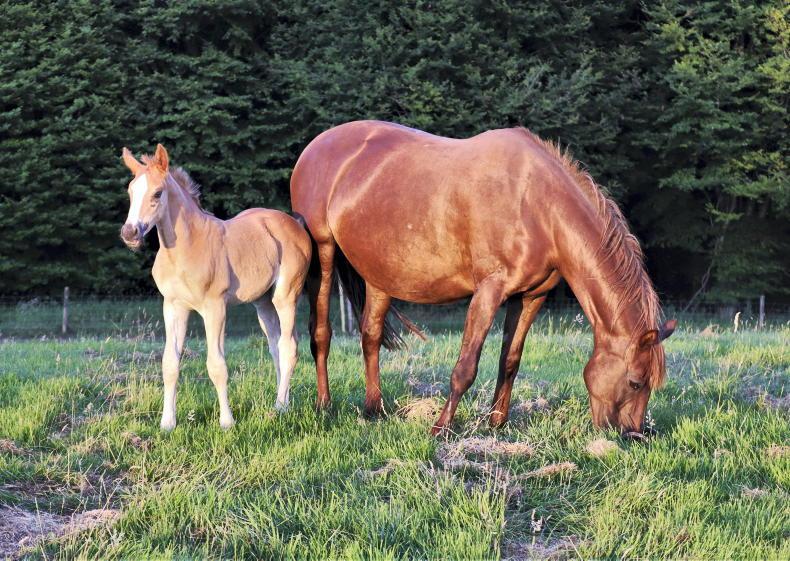WITH both horses and hounds preparing to get back to the hunting field in the coming months, it is a good time to look at your hunter’s diet in detail and make any necessary changes at this time before your horse progresses into harder work.
We know the hunting field is a nursery for many horses and ponies who will progress to other equestrian sports but the typical hunter is often a traditionally Irish-bred horse, strong-limbed and sure-footed, chosen for its soundness, agility and ridability.
These heavier types of horses can require plenty of slow steady work to rebuild their fitness after a summer break at grass.
Worming
Reviewing your worming programme (and taking appropriate action with worm counts or a proper veterinary working plan in place), checking your horse’s dentition and ensuring you have good quality saved forage for the winter period ahead are all essential tasks at this time.
The next step with all horses returning to work is to assess their body condition score. There are many body condition scoring charts available online to assist you in doing so. While assessing your horse’s body condition score, you will visually assess the fat cover over various areas of the body including neck, shoulder, back, ribs, loin, croup and hind quarter.
Low calorie diet
If your assessment indicates that your horse is too fat at this time, you will need to avoid calorie-rich concentrates and instead utilise a low calorie nutrient dense feed balancer alongside your pasture/hay/haylage while you work on trimming down your horse through a targeted exercise programme which can include road-work and steady cantering.
If your assessment indicates that your horse is thin at this time, you will need to look for a high calorie feed with a balanced trace mineral and vitamin inclusion and feed this alongside ad lib good quality forage. It may be useful to seek further advice.
Once a horse is in steady work, no matter what level, particular attention should be given to the diet. The demands of exercise place stresses on the horse’s body that would normally not occur if the horse was just turned out to pasture.
Necessary fibre
The energy requirements of your hunter will increase according to their workload.
The body of the horse is well adapted to storing and mobilising energy from various types of nutrients, e.g., fibre, sugar, starch and fat.
Fibre is often overlooked as an energy source, however, the digestive tract of the horse is designed to obtain energy from forages. This source of energy is not produced very rapidly and is therefore suited for moderate to low intensity work.
Starch and sugars (non-structural carbohydrates) mainly found in cereals and molasses provide a more readily available source of energy suitable for short bursts of speed.
Diets high in non-structural carbohydrates can also increase excitability and therefore should be avoided in ‘fizzier’ types of horses.
Added dietary fat in the form of an oil or stabilised rice bran is another source of energy for the horse. The advantages of adding fat to the diet is the concentrated nature of the energy which enables it to be fed in smaller amounts. It is also considered a slow releasing energy source and will be very suitable for hunters who are often ridden for many hours on a day’s hunting.
Oxidative damage
The harder your hunter works and the more frequently they are hunted, the more vitamins and minerals the horse requires. For example, muscle contractions during exercise cause oxidative damage to muscle cells: vitamin E works as an antioxidant to help restore muscle membrane integrity.
Similarly, B vitamins are used during the cycle of energy synthesis and therefore as the level of work increases so does the animal’s requirement for these vitamins. The stress of intense exercise on bones may also slightly increase the need for calcium, phosphorus, magnesium, copper and zinc.
For horses, hunting a number of days per week, feed a concentrate designed for performance horses. Take these requirements into consideration and ensure your hunter has sufficient energy and staying power while out in the hunting field and also has the nutrients it needs to recover from the strains of a busy day by providing adequate trace minerals and vitamins to support muscle recovery.
Salt lick
Provide access to a salt lick for stabled horses and replenish electrolytes lost in sweat after a day in the hunting field by providing your horse with a good quality performance electrolyte at the recommended levels. This will aid their recovery.
While a day of rest was traditionally given to horses after a day’s hunting, it is important that they get a chance to stretch their legs. Turn-out time in a suitable paddock or some time on a horse walker will be sufficient to provide them with the opportunity to loosen up while you have the chance to confirm their soundness after the previous day’s work.
Plenty of good quality forage will keep them chewing happily for the remainder of the day once they return to their box. Carry out a regular review of body condition throughout the season and make any changes to the diet gradually, if required.
Joanne Hurley M.Agr.Sc., head of equine, Gain Equine Nutrition, and the team at Gain Equine Nutrition are happy to advise horse owners on feeding their horses for maximum health and performance. Gain Nutrition have an excellent help and advice page on their website: gainanimalnutrition.com.




 This is a subscriber-only article
This is a subscriber-only article
 It looks like you're browsing in private mode
It looks like you're browsing in private mode











SHARING OPTIONS: